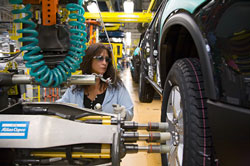Changing the Auto Industry from the Wheels Up
The problems of the U.S. auto industry call for radical solutions.
This is a web-only article from the website of Dollars & Sense: The Magazine of Economic Justice available at http://www.dollarsandsense.org

This is a web-only article, available only at www.dollarsandsense.org.
Subscribe Now
at a 30% discount.
Intro | Pt. I | Pt. II | Pt. III | Pt. IV| Pt. V | Pt. VI | Full article

Photo by Jim West
Part VI: Workers’ Control
The failings of management have triggered calls for the replacement of particular executives, but should also be an opportunity to question the entire system of top-down management.
The Big Three managements have led the companies and their workers to the brink. As BusinessWeek’s Detroit bureau chief David Welch writes in his account of GM’s fall from the pinnacle of the auto industry, management “just made too many mistakes for too long.” [Note 68] The requests by GM and Chrysler for public money triggered calls for the ouster of at least top executives, and the Obama administration insisted in late March on the resignation of GM head Rick Wagoner as a condition for further government assistance. [Note 69] So far, however, calls for a change in the top management personnel have not come with calls for broader changes to the authoritarian system of control that pervades capitalist corporations.
The arguments for workers’ control of production are, ultimately, the familiar principles of self-government: All people should be able to make for themselves the decisions that affect their lives, and should not have to accept decisions imposed on them. When such decisions affect many people, each should be able to participate equally in a system of collective decision-making. People should not to have to answer to a lord, a master, or a boss. The authoritarianism of the capitalist workplace collides with these principles. In the workplace, most people do not have—or, very often, expect—the right to make decisions for themselves or to elect representatives to whom they delegate decision-making authority (and whose authority they can revoke if they decide). Instead, they answer to a boss, whether the owner of the company where they work or a delegate of the owners, who definitely does not rule by consent of the governed. The principles of self-government are an important part of U.S. political culture, and so offer an opening to discussions of workplace democracy in this country. They are also universalistic principles, demanding the equal inclusion of all, irrespective of national borders or any other dividing lines.
Ideas of workers’ control have a long history in the United States, but are no longer really part of the culture of the U.S. labor movement. During their post-World War II heyday, U.S. unions by-and-large accepted that the production process, product design, pricing, and other major decisions were “management prerogatives.” In return, workers in “core” industries (like auto, steel, and trucking) got recognition of their unions, real-wage increases tied to productivity growth, steady employment, and the benefits of the private welfare state. This arrangement is often known as the “capital-labor accord,” or the “limited capital-labor accord,” since it never covered all—or even most—U.S. workers. [Note 70] Since the 1970s, employers have shredded their side of the bargain. The “management prerogatives,” however, have remained.
Early reports of Chrysler’s restructuring plan, under which the UAW retirees’ health-care trust would get 55% of the stock in the company, suggested that the union would “own” or “control” the company. The union quickly denied that it would control Chrysler, pointing out that the retiree health-care trust was an independent entity and assuaging any fears that the union would be making managerial decisions at the company. [Note 71] (The UAW also announced that the trust would quickly sell off its shares to pay out benefits. [Note 72]) This defensiveness suggests the hostility in mainstream political culture to any hint of workers’ control. In reality, though, the Chrysler deal does not involve workers’ control or ownership in any meaningful way. The restructuring plan includes different categories of stock, and the category that the trust holds is defined in a way that means that the trust’s 55% does not constitute a majority of the voting power. [Note 73] The trust would have only one (non-voting) seat on the board of directors, compared to four seats for the U.S. government and three for Fiat. The Wall Street Journal reported that Fiat’s CEO would become the head of Chrysler or appoint someone else to the position. [Note 74] Under the Chrysler restructuring plan, it is Fiat, not the union or the workers, that will have operational control of the company.
As bankrupt as the current system of top-down management may be, a new system will not come about automatically, nor without a fight. For the auto industry, it is not likely to come about at all without a major upsurge in workers’ resistance to the current restructuring. This may take place through the UAW and other existing unions, come from outside the existing unions (through the emergence of new workers’ organizations or through “wildcat” actions), or both. The labor upsurge of the 1930s, which created the UAW and other major unions, took both forms. The fight-back today need not begin with a highly ideological commitment to a new system of workers’ control. It may begin with something as basic as a refusal to accept layoffs. Workers at the Chicago-area manufacturer Republic Windows and Doors, who sat-in at their factory in December rather than accept layoffs, offer an example of such resistance. [Note 75] The tactic, a factory occupation, echoes the origins of the UAW itself—whose sit-down strikes unionized GM in the 1930s. [Note 76]
For the auto industry today, the fight-back would have to involve enormous numbers of workers, and not just in Detroit, but across the world. The auto companies are worldwide employers. Right now, to the extent that the discussion of the industry’s future is about the fates of the workers, it is mainly limited to U.S. workers. A partially or fully nationalized U.S. auto company or industry (under whatever system of control), however, would not necessarily protect the interests of workers in other countries. Proponents of workers’ self-management should advocate for the rights of all workers and their equal inclusion in any future system of control. Ultimately, however, whether the voices of workers, here or abroad, are heard will depend primarily on their own capacity for collective action and their own demands for real democracy.
Intro | Pt. I | Pt. II | Pt. III | Pt. IV| Pt. V | Pt. VI | Full article
End Notes:
68. David Welch, How GM Lost its Sales Crown to Toyota, BusinessWeek, January 22, 2009.
69. Outside Pressure Grows for GM to Oust Wagoner, Wall Street Journal, December 8, 2008; Neil King Jr. and John D. Stahl, Government Forces Out Wagoner at GM, Wall Street Journal, March 30, 2009.
70. David Montgomery, Workers’ Control in America, Cambridge University Press, Cambridge, 1980.
71. Matthew Dolan, UAW Says Won’t Control Chrysler, Wall Street Journal, May 1, 2009.
72. UAW trust intends quick sale of Chrysler stake, Reuters, May 5, 2009.
73. Alisa Priddle and David Shepardson, UAW trust won’t get control of Chrysler, Detroit News, April 29, 2009.
74. Christine Tierney, Treasury will administer VEBA’s Chrysler stake, Detroit News, April 30, 2009; Neil King Jr. and Jeffrey McCracken, Chrysler Pushed into Fiat’s Arms, Wall Street Journal, May 1, 2009.
75. Monica Davey, In Factory Sit-In, an Anger Spread Wide, New York Times, December 7, 2008.
76. Monica Link and Larry Gabriel, The Flint Sit-Down Strike, UAW Solidarity, Jan.-Feb. 2003.
Did you find this article useful? Please consider supporting our work by donating or subscribing.
